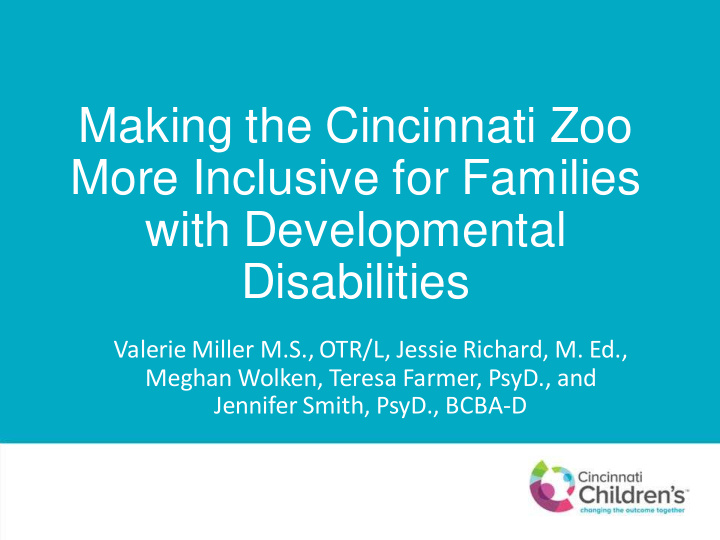



Making the Cincinnati Zoo More Inclusive for Families with Developmental Disabilities Valerie Miller M.S., OTR/L, Jessie Richard, M. Ed., Meghan Wolken, Teresa Farmer, PsyD., and Jennifer Smith, PsyD., BCBA-D
Background • It is estimated that 483,467 or 17.8% of Ohio’s children have a special healthcare need (National Survey of Children with Special Health Care Needs, 2009-2010) • 7.84% of children with disabilities ages 3-21 receiving special education services in Ohio were reported as having autism Spectrum Disorder (Easter Seals Inc., 2015) • Families of children with developmental disabilities seek “typical family outings” that are meaningful, enjoyable, and interesting to their child (Langa et al., 2013)
Background • Families that have children with developmental disabilities usually experience decreased participation in community activities due to: • Negative emotions while participating (Lam, Wong, Leung, Ho, & Au-Yeung, 2010) • Feelings of criticism and judgment from the general public (Kulik & Fletcher, 2016) • Feelings of isolation due to lack of understanding/empathy from general public/staff (Thompson & Emira, 2016)
SOAR Program • SOAR- Starting our Adventure Right • Started with the Cincinnati Airport • Now includes: • The Cincinnati Children’s Theater • Duke Energy Children’s Museum • The Cincinnati Ballet • SOAR provides staff training and resources to community agencies to better serve families of children with developmental disabilities
The Cincinnati Zoo • The Cincinnati Zoo and Botanical Gardens is the second oldest Zoo in the country • Rated as a top family attraction in Cincinnati • Currently the Cincinnati Zoo recognizes a need to reach families of children with disabilities but is unsure of how to approach this task
Goals of the Study • To understand the experience of families of children with developmental disabilities at the Cincinnati Zoo • To understand barriers and supports to attending the Cincinnati Zoo • To provide information to the Cincinnati Zoo to help with future efforts to be more inclusive
Project Method • Three focus groups with 5 to 8 non-paid primary caregivers who self-identified as caring for a child, adolescent, or adult with a Developmental Disability • Ages 2-10 years • Ages 11 and up • Mixed ages • Each group lasted approximately 90 minutes • Each group facilitated by one of the LEND trainees of the research team • Video and audio recording were utilized and transcribed and themes were developed
Recommendations by Group 2 to 10 Years 10 Years & Up Mixed Ages • Security of Physical • Staff Training on • Educating Staff on the Space Disabilities Challenges of Caring • Staff Training on • Sensory Maps & Kits for a Child with a Disabilities • Renaming of Nursing Disability • Improvements to Station • Accessible Playground Nursing Station • Calming Space • Disability Attendant • Calming Space • Accessible Bathroom • Calming Space • Disability Friendly Equipment • Accessible Viewing Events • Developmentally Options • Inclusive Camps Appropriate Camps • Accessible Bathroom • Additional Family • Membership Equipment Bathrooms Accommodations • Membership • Sensory Friendly • Disability Friendly Accommodations Bathrooms Events • Interactive • Identification System • Entrance Flow Technological Resources • Employment
Overall Themes Facility Improvement s Aids and Staff Training Supports Universal Themes Programmin Safety g Concerns Improvement s
Discussion • Feedback for the Cincinnati zoo was overwhelmingly positive across all three groups, and it should be noted that data was only analyzed regarding improvements to the zoo • Similarities between the groups focused on the need for disability-friendly events, the need for calming spaces, and the need for staff education • Differences identified between the age groups including the younger aged groups discussing concerns with safety while the older-aged groups focused more on accessibility and employment opportunities with the Cincinnati Zoo
Next Steps • Information from the focus groups will be provided to the Cincinnati Zoo • Surveys will be provided to families who were not able to attend the focus groups but wanted to participate, and survey data will be analyzed • Cincinnati LEND will continue to work with the zoo to identify reasonable next steps to implement change
Thank you! Contact Information: Valerie Miller, M.S. OTR/L Valerie.Miller2@cchmc.org
References • Easter Seals, INC. (2015). 2015 Ohio State Autism Profile. Retrieved from http://www.easterseals.com/explore-resources/living-with-autism/profiles- ohio.html?referrer=https://wwww.google.com/ • Lam, S.F., Wong, B.P., Leung, D., Ho, D., & Au-Yeung, P. (2010). How parents perceive and feel about participation in community activities: the comparison between parents of preschooler with and without autism spectrum disorders. Autism, 14 (4), 359-377. • Langa, L.A., Monaco, P., Subramaniam, M., Jaeger, P.T., Shanahan, K., & Ziebarth, B. (2013). Improving the museum experiences of children with autism spectrum disorders and their families: An exploratory examination of their motivations and needs and using web-based resources to meet them. Curator: The Museum Journal, 56 (3), 323-335. • Kulik, T. K., & Fletcher, T.S. (2016). Considering the museum experience of children with autism. Curator: The Museum Journal, 59 (1), 27-38. • National Survey of Children with Special Health Care Needs (NS-CSHCN) (2009). 2009- 2010 National Survey of Children with Special Health Care Needs. Retrieved from http://wwww.childhealthdata.org • Thompson, D., & Emira, M. (2011). ‘They say every child matters, but they don’t’: an investigation into parental and caregiver perceptions of access to leisure facilities and respite care for children and young people with Autism
Recommend
More recommend